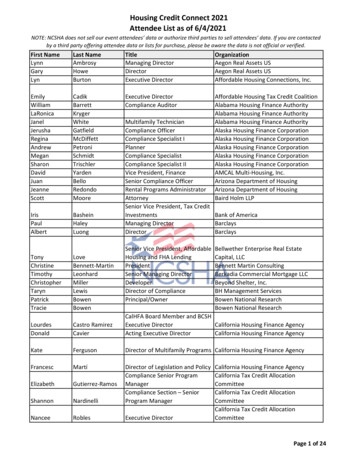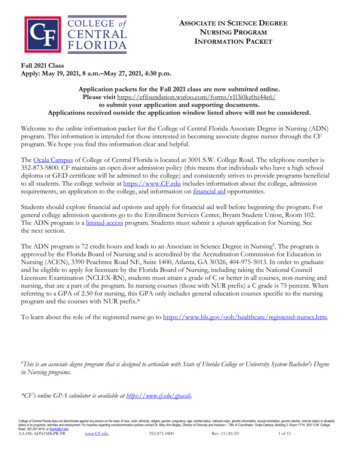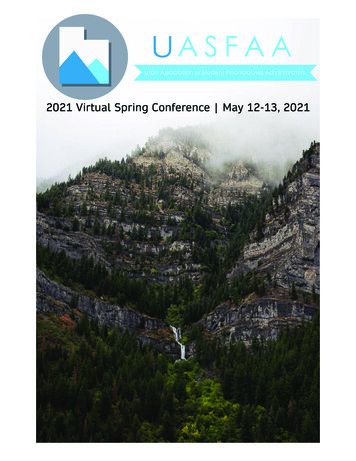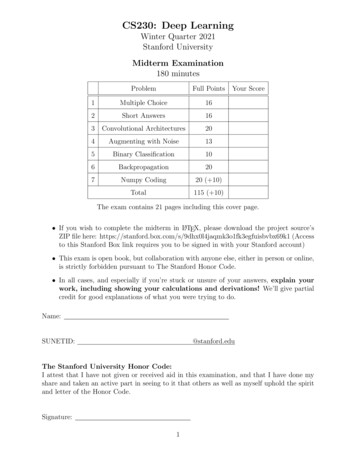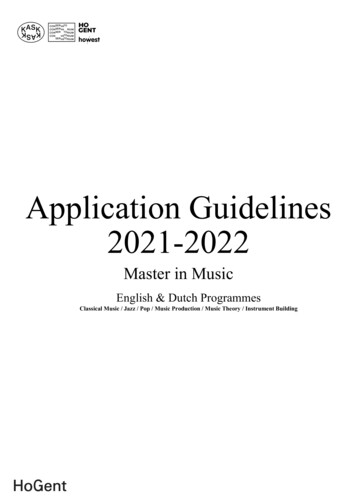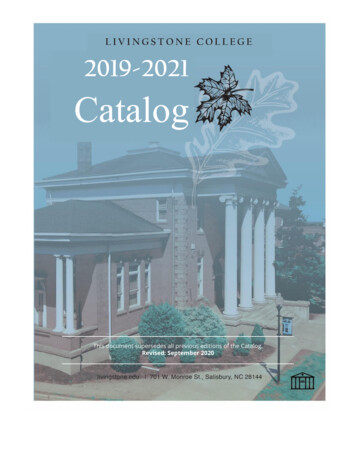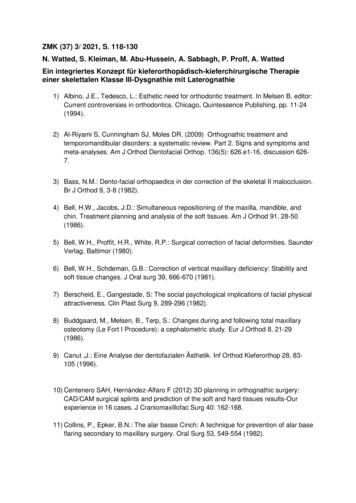
Transcription
ZMK (37) 3/ 2021, S. 118-130N. Watted, S. Kleiman, M. Abu-Hussein, A. Sabbagh, P. Proff, A. WattedEin integriertes Konzept für kieferorthopädisch-kieferchirurgische Therapieeiner skelettalen Klasse III-Dysgnathie mit Laterognathie1) Albino, J.E., Tedesco, L.: Esthetic need for orthodontic treatment. In Melsen B, editor:Current controversies in orthodontics. Chicago, Quintessence Publishing, pp. 11-24(1994).2) Al-Riyami S, Cunningham SJ, Moles DR. (2009) Orthognathic treatment andtemporomandibular disorders: a systematic review. Part 2. Signs and symptoms andmeta-analyses. Am J Orthod Dentofacial Orthop. 136(5): 626.e1-16, discussion 6267.3) Bass, N.M.: Dento-facial orthopaedics in der correction of the skeletal II malocclusion.Br J Orthod 9, 3-8 (1982).4) Bell, H.W., Jacobs, J.D.: Simultaneous repositioning of the maxilla, mandible, andchin. Treatment planning and analysis of the soft tissues. Am J Orthod 91, 28-50(1986).5) Bell, W.H., Proffit, H.R., White, R.P.: Surgical correction of facial deformities. SaunderVerlag, Baltimor (1980).6) Bell, W.H., Schdeman, G.B.: Correction of vertical maxillary deficiency: Stability andsoft tissue changes. J Oral surg 39, 666-670 (1981).7) Berscheid, E., Gangestade, S: The social psychological implications of facial physicalattractiveness. Clin Plast Surg 9, 289-296 (1982).8) Buddgaard, M., Melsen, B., Terp, S.: Changes during and following total maxillaryosteotomy (Le Fort I Procedure): a cephalometric study. Eur J Orthod 8, 21-29(1986).9) Canut ,J.: Eine Analyse der dentofazialen Ästhetik. Inf Orthod Kieferorthop 28, 83105 (1996).10) Centenero SAH, Hernández-Alfaro F (2012) 3D planning in orthognathic surgery:CAD/CAM surgical splints and prediction of the soft and hard tissues results-Ourexperience in 16 cases. J Craniomaxillofac Surg 40: 162-168.11) Collins, P., Epker, B.N.: The alar basse Cinch: A technique for prevention of alar baseflaring secondary to maxillary surgery. Oral Surg 53, 549-554 (1982).
12) Dal Pont G.: L osteotomia retromolare per la correzione della progenia, Minerva chir.18, 1138-1141 (1959).13) Dal Pont G.: Die retromolare Osteotomie zur Korrektur der Progenie, der Retrogenieund des Mordex apertus. Öst Z Stoma 58, 8-10 (1961).14) Dryland-Vig, K.W.L., Ellis III, E.: Diagnosis and treatment planning for the surgicalorthodontic Patient. Cli Plast Surg 16, 645-658 (1989).15) Dann, J.J., Fonseca, R.J., Bell, W.H.: Soft tissue changes associated with totalmaxillary advancement: a preliminary study. J Oral Surg 34, 19-23 (1976).16) De Assis, E.A., Starck, W.J., Epker, B.: Cephalometric analysis of profile nasalesthetics. Part III. Postoperativ changes after isolated superior repositioning. Int JAdult Orthod Orthognath 11, 279-288 (1996).17) Ellis, E.: Condylar Positioning Devices for Orthodontic Surgery: Are They Necessary.J Oral Maxillofac Syrg 52, 536-552 (1994).18) Ellis, E., Hinton R.J.: Histologic examination of the temporomandibular joint aftermandibular advancement with and without rigid fixation: An experimental investigationin adult Maccaca mulatta. J Oral Maxillofac Syrg 49, 1316 (1991).19) Epker, B.: Esthetic maxillofacial surgery. Lea und Febiger Verlag, Philadelphia(1994).20) Epker, B. N., Fish, L. C.: Surgical-orthodontic correction of open-bite deformity. Am JOrthod 71, 278-299 (1977).21) Epker, B.N., Fish, L.C.: Surgical superior repositioning of the maxilla: What to do withthe mandibile?. Am j Orthod 78, 164-191 (1980).22) Farkas, L.G., Kolar, J.C.: Anthropometry and art in the aesthetics of women s face.Clin Plast Surg 14, 599-615 (1987).23) Flanary, C.M., Barnwell, G.M., Alexander, J.M.: Patient perceptions of orthognathicsurgery. Am J Orthod 88, 137-145 (1985).24) Floris F: Korrektur einer Progenie durch chirurgischen Eingriff. In: Verhandlungen desV. Internationalen zahnärztlichen Kongresses, Band II: 363-366, 1909.25) Helm, S., Siersbaek-Nielsen, S., Skieller, V., Björk, A.: Skelatal maturation of thehand in relation to maximum puberal growth in body height.Danish Dental Jornal 75,1223-1234 (1971).26) Hogeman, K.E., Sarnäs, K.V., Willmar, K.: One-stage surgical and dental-orthopediccorrection of bimaxillary and craniofacial dysostosis. In: Fortschr Kiefer Gesichtschr,Bd 18: 39-49, Thieme Verlag, Stuttgart (1974)
27) Hui, E., Hägg, E.U.O. Tidman, H: Soft tissue changes following maxillary osteotomiesin cleft lip and palate and non-cleft Patients. J Craniomaxillofac Surg 22, 182-186(1994).28) Jensen, A.C., Sinclair, P.M., Wolford, L.M.: Soft tissue changes associated withdouble jaw surgery. Am J Orthod Dentofac Orthop 101, 266-275 (1992).29) Jacobson, A.: The influence of children s dentofacial appearance on their socialattractiveness as judged by peers and lay adults. Am J Orthod 79, 399-415 (1981).30) Joss CU, Vassalli IM. Stability after bilateral sagittal split osteotomy dvancementsurgery with rigid internal fixation: a systematic review. J Oral Maxillofac Surg.2009;67:301-1331) Kiyak, H.A., Hohl ,T., West, R.A.: Psychologie changes in orthognathic surgerypatients: a 24-month follow-up. J Oral Maxillofac Surg 42, 506-512 (1984).32) Lazaridou-Terzoudi T, Kiyak HA, Moore R, Athanasiou AE, Melsen B (2003) Longterm assessment of psychologic outcomes of orthognathic surgery. J Oral MaxillofacSurg 61:545–55233) Legan, H.L., Burstone, G.J.: Soft tissue cephalometric analysis for orthognathicsurgery. J Oral Surg 38, 744-51 (1980).34) Lee, D.Y., Bailey, L.J., Proffit, W.R.: Soft tissue changes after superior repositioningof the Maxilla with Le Fort I osteotomy: 5-years follow-up. Int J Adult OrthodOrthognath 11, 301-311 (1996).35) McNamara, J.A.,McDougall, Jr.P.D., Dierks, J.M.: Arch with development in Class IIpatients treated with extraoral force and functional jaw orthodontics. Am J Orthodont52, 353-359 (1966).36) Mensink G, Verweij JP, Frank MD, Eelco BJ, Richard van Merkesteyn JP. Bad splitduring bilateral sagittal split osteotomy of the mandible with separators: aretrospective study of 427 patients. Br J Oral Maxillofac Surg. 2013;51:525–529.37) Mensink G, Zweers A, Wolterbeek R, Dicker GG, Groot RH, van Merkesteyn RJ.Neurosensory disturbances one year after bilateral sagittal split osteotomy of themandibula performed with separators: A multi-centre prospective study. JCraniomaxillofac Surg. 2012;40:763–767.38) Obwegeser, H.: The surgical correction of mandibular prognathism and retrognathiawith consideration of genioplasty. J Oral Surg 10, 677-689 (1957).39) Obwegeser, H.: The indication for surgical correction of mandibular deformity bysagittal splitting technique. Br J Surg 1, 157-168 (1963).40) Obwegeser, H., Trauner, R.: Zur Operationstechnik bei der Progenie und anderenUnterkieferanomalien. Dtsch Zahn Mund Kieferheilk 23, 1-26 (1955).
41) Petrovic, A.G., Stutzmann, J.: Reaktionsfähigkeit des tierischen und menschlichenKondylenknorpels auf Zell- und Molekularebene im Lichte einer kybernetischenAuffassung des faszialen Wachstums. Fortschr Kieferorthop 49, 405-425 (1988).42) Proothi M, Drew SJ, Sachs SA. Motivating factors for patients undergoingorthognathic surgery evaluation. J Oral Maxillofac Surg. 2010;68:1555–155943) Radney, L.J., Jacobs, J.D.: Soft tissue changes associated with surgical totalmaxillary intrusion. Am J Orthodont 80, 191-212 (1981)44) Rosen, H.M.: Lip-nasal esthetics follwing Le Fort I Osteotomy. Plast Reconstr Surg81, 171-182 (1988)45) Schwarz, A.M.: Die Röntgendiagnostik. Urban & Schwarzenberg, Wien (1958).46) Scott, O., Kijak, H.A.: Treatment expectation versus outcomes among orthodonticsurgery patients. Int J Adult Orthod Orthognath Surg 6, 247-255 (1991).47) Solano-Hernandez B, Antonarakis GS, Scolozzi P, Kiliaridis S.Combined orthodontic and orthognathic surgical treatment for the correction of skeletalanterior open-bite malocclusion: a systematic review on vertical stability. J Oral MaxillofacSurg 71(1):98-109 (2013).48) Watted, N., Witt, E.: NMR study of TNJ changes following functional orthopaedictreatment using the "Würzburg approach", Europen Orthodontic Society (EOS) 74 thCongress (1998).49) Watted, N.: Behandlung von Klasse II-Dysgnathien- FunktionskieferorthopädischTherapie unter besondrer Berücksichtgung der dentofazialen Ästhetik, Kieferorthop13, 193-208 (1999).50) Watted, N., Bill, J., Witt, E.:Therapy Concept for the Combined Orthodontic-SurgicalTreatment of Angle Class II Deformities with Short Face Syndrome New Aspects forSurgical Lengthening of the Lower Face. Clinc. Orthod. Res. 3, 78-93 (2000).51) Watted, N., Abu-Hussein, M. Watted, A., Bill, J., Proff, P., Schlomi, B. Änderung derskelettalen Strukturen zur Harmonisierung der Weichteilstrukturen im Gesicht,Oralchirurgie Journal 12: 41-48 (2015)52) Watted, N., Abu-Hussein, M., Bill, J., Proff, P: Harmonisation of the Dento-FacialComplex A Result Of Combination A Orthodontic and Orthognathic Surgical Therapy.IOSR Journal of Dental and Medical Sciences (IOSR-JDMS)14, 2: 128-139., (2015)53) Westermark, A.H., Bystedt, H., von Konow, L., Sällström, K.O.: Nasolabialmorphology after Le Fort I Osteotomies. Int J Oral Maxillofac Surg 20, 25-30, (1991).
54) Williamsone, E.H., Caves, S.A., Edenfield, R.J., Morse, P.K.: Cephalometric analysis:comparisons between maximum intercuspation and centric relation, Am J Orthod 74,672-677 (1978).55) Williamsone, E.H., Evans, D. L., Barton, W.A., Williams B.H.: The effect of bite planeuse on terminal hinge axis location. Angle Orthod 47, 25-33 (1977).56) Witt, E.: Möglichkeiten und Grenzen der kieferorthopädischen BehandlungErwachsener. Fortschr Kieferorthop 52, 1-7 (1991)57) Witt, E.: Behandlungskonzepte. In Miethke, R.R., D. Drescher (Hrsg.): KleinesLehrbuch der Angel-Klasse II,1 unter besonderer Berücksichtigung der Behandlung.Quintessenz, Berlin (1996).
46) Scott, O., Kijak, H.A.: Treatment expectation versus outcomes among orthodontic surgery patients. Int J Adult Orthod Orthognath Surg 6, 247-255 (1991). 47) Solano-Hernandez B, Antonarakis GS, Scolozzi

